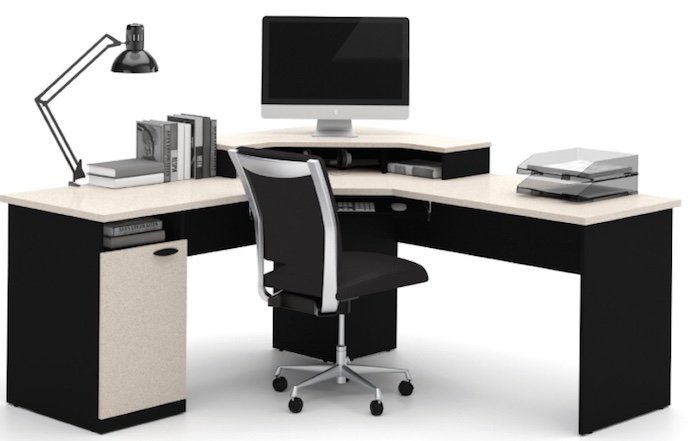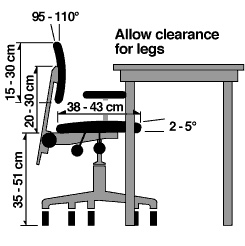
When we work in an office setting—either at an employer’s site or in our home office—most of that time tends to be spent sitting at a computer. That goes for PC gaming as well. That domination of the computer as the critical piece of equipment is why the first reaction many people have to the challenge of boosting productivity is to upgrade to something faster or to invest in new software. Both of those can be wins, but what’s often overlooked is that the environment we’re working in can actually be a much bigger drag on productivity than a slow PC. And when that PC is replaced, a poorly laid out office is going to negatively impact use of that speedy new PC just as much as it did the older one.
What’s even worse is that throwing a workspace together without considering the ergonomics of the situation can not only cause productivity to take a hit, it can cause physical injury. If you find your arms, wrists, back, neck or eyes feel strained after a few minutes of working at your computer, you need to consider giving your office an ergonomic overhaul. And if tasks just seem to take longer than they should—between swivelling from computer screen to telephone or constantly walking over to a printer, fax machine, file cabinet or scanner—it’s time to consider the ergonomics of your current office or workspace layout.
What Makes an Office Ergonomic
An ergonomic office is one where the equipment, furniture and their arrangement have been designed specifically to ensure the person working in the room is able to interact with everything in an optimal manner. In other words, everything is carefully chosen and placed to make working as comfortable and as efficient as possible.
This means knowing how the workspace is going to be used and planning the layout to reflect that use. It might result in having to move furniture or equipment, or possibly replace some pieces with more appropriate ones, but the payoff can be tremendous. In an ergonomic office, you tend to find task chairs, computer desks and wireless printers. Sorry, but your dining room table, or a spare room cluttered with whatever leftover furniture and equipment you’ve been able to collect probably doesn’t qualify …

This office setup is an erogonomic nightmare and caused my biggest productivity slowdown since the release of Fallout 4.
I’m in the middle of an office renovation at the moment and as a result, my computer, laptop, keyboards and other accessories have all been temporarily crammed onto one tiny workspace (see the photo above). Everything I need is there and it’s even a standing desk (of sorts), but it’s an ergonomic nightmare. This is exactly the kind of setup that should be avoided at all costs.
How an Ergonomic Office Makes You More Productive
Working in an ergonomic office has a big payoff when it comes to productivity. When set up optimally, you’ll find that you are able to work more effectively and with less time wasted.
For example, investing in a widescreen monitor means less time scrolling around, more windows open and viewable and it can mean less squinting as well. For full details on the productivity benefits of a widescreen monitor—including gaining an additional 19,000 productivity days a year for a 250 person company that adopts the technology—check out Steven Hill’s post on the subject.
 Working in an ergonomic office means not having to get up an walk to the other side of the room every time you print something, not having to fully extend your arms to reach your keyboard and not having to deal with a tiny restricted space to use your mouse. If you spend a lot of time on the phone, you should have a headset. That monitor should be properly position for your height to prevent neck strain. Your chair should be comfortable, offer lumbar support and be fully adjustable. Lighting should be sufficient to be able to easily read text printed on paper, but positioned so that it doesn’t cause reflection and glare on your computer screen.
Working in an ergonomic office means not having to get up an walk to the other side of the room every time you print something, not having to fully extend your arms to reach your keyboard and not having to deal with a tiny restricted space to use your mouse. If you spend a lot of time on the phone, you should have a headset. That monitor should be properly position for your height to prevent neck strain. Your chair should be comfortable, offer lumbar support and be fully adjustable. Lighting should be sufficient to be able to easily read text printed on paper, but positioned so that it doesn’t cause reflection and glare on your computer screen.
When everything you need is within easy reach and you’re comfortable, you will be more productive. A faster PC is nice to have, but it won’t help your type any faster; on the other hand, a good quality ergonomic keyboard combined with a proper task chair and a computer desk that adjusted for optimal keyboarding means faster and more accurate work.
The Canadian Centre for Occupational Health and Safety publishes everything you need to know about ergonomic office specifics, including guidelines like the ergonomic chair graphic.
The Health benefits of an Ergonomic Office
Working in an ergonomic office doesn’t just pay off in sheer output, it goes a long way toward preventing the kind of repetitive stress injuries (RSI) that plague computer users. These are conditions like Carpal Tunnel Syndrome or Tendonitis that can be caused by working at a computer without paying attention to ergonomics.
According to Government of Canada statistics, two million Canadians suffer from repetitive strain injuries, many of which are office-related. The problem is serious and widespread enough that that the Government has designated the last day of February every year as Repetitive Strain Injury Awareness Day. I suffered a bout of Tendonitis when working at a job where office appearance was a higher priority than ergonomics and it was not a fun episode. Keyboard drawers may add a bit of visual clutter compared to a streamlined, minimalist table-style desk, but having to wear wrist braces while working on a PC takes away from the whole aesthetic in an even bigger way—while also causing productivity to take a hit …
Typical Equipment Upgrades for Maximum Ergonomic Effect
 In order to set up a workspace or office to reap the maximum productivity benefits of being ergonomic, there are several key piece of equipment that factor into most scenarios.
In order to set up a workspace or office to reap the maximum productivity benefits of being ergonomic, there are several key piece of equipment that factor into most scenarios.
- A wireless, ergonomic keyboard and mouse (the Microsoft Sculpt combo is a great example)
- Widescreen computer monitor with either height adjustment or a stand
- Task-appropriate workstation or desk, ideally one that offers a keyboard drawer
- Adjustable office chair that’s comfortable, supportive and designed for the primary task (such as computer use, gaming or writing)
- Wireless multifunction printer ( a great option since it lets you place a print/scan fax centre within convenient reach without having to worry about physically connecting to a PC or router)
It may sound intimidating (and expensive), but setting up an ergonomic office doesn’t have to be either. Re-jigging the existing layout to be more user-friendly can be done in a matter of hours, while equipment and furniture can be added over time. Don’t just put up with the status quo—especially if you’re currently using a makeshift setup like the dining room table—because nothing brings productivity to a grinding halt fast than a RSI …



